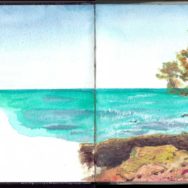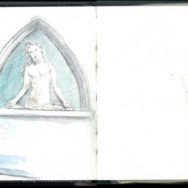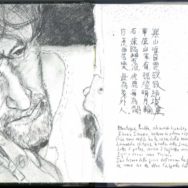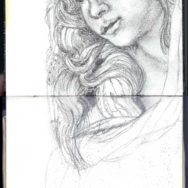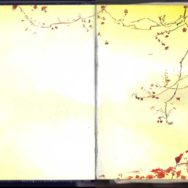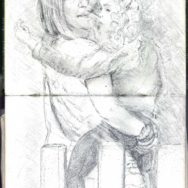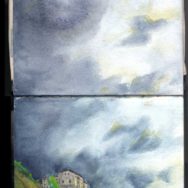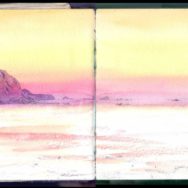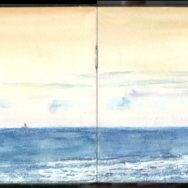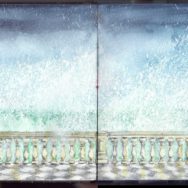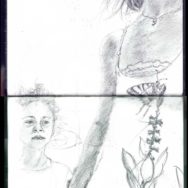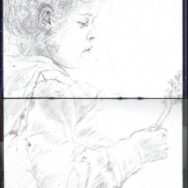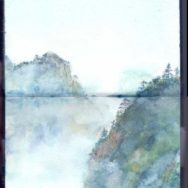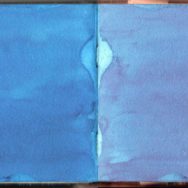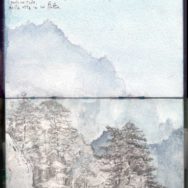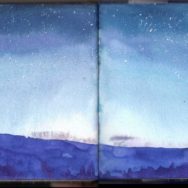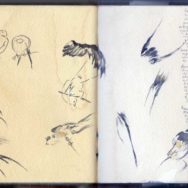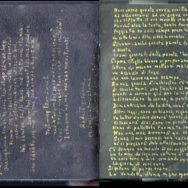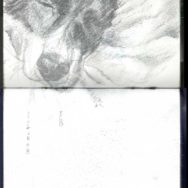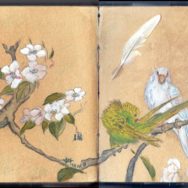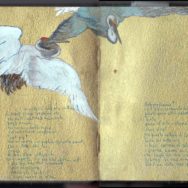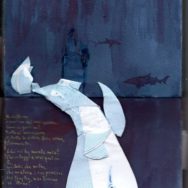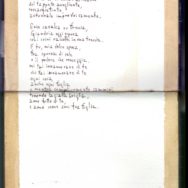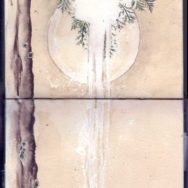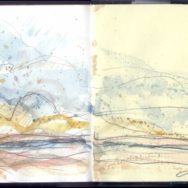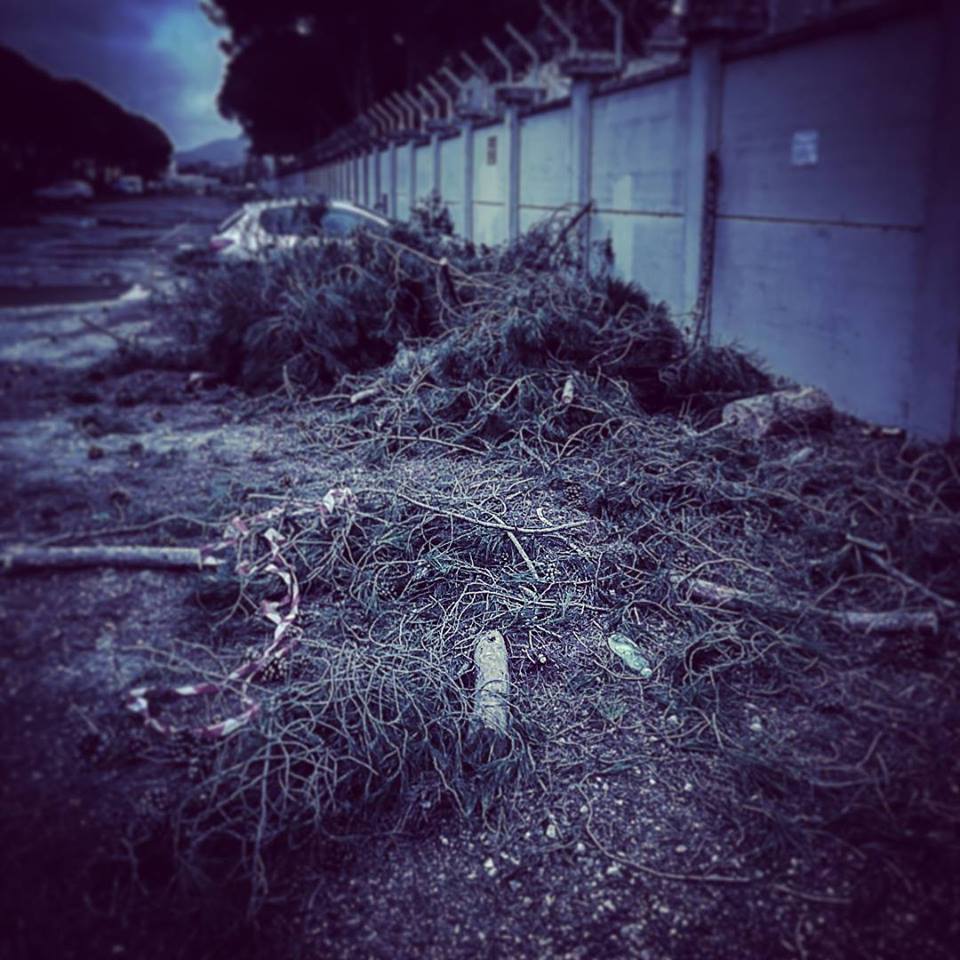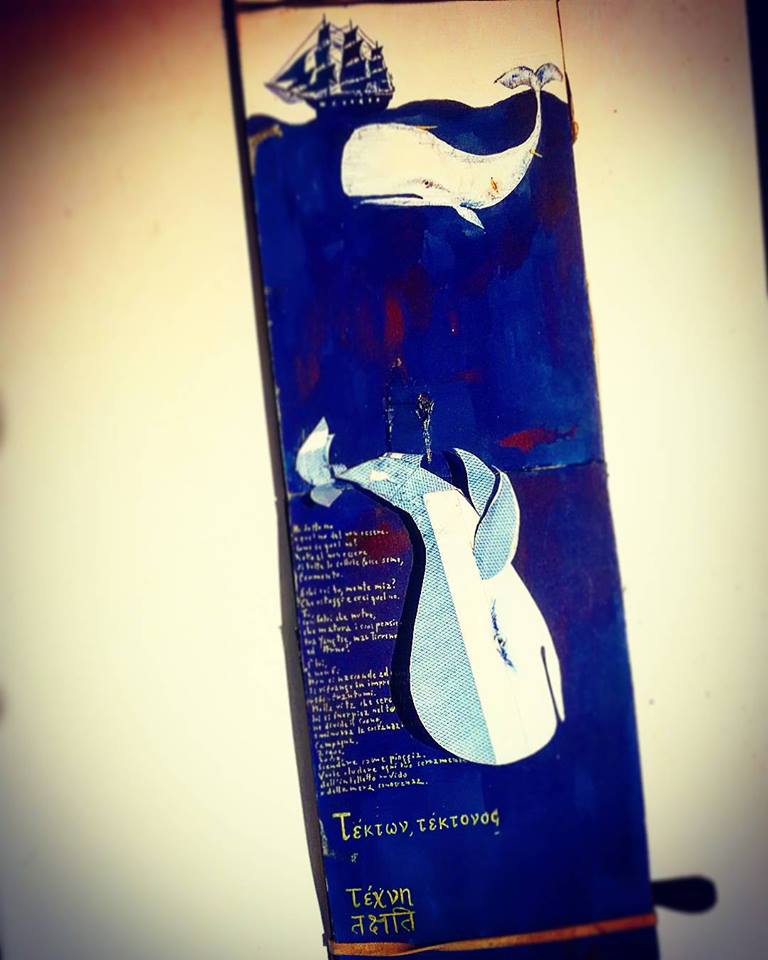DRUNKEN LUOHAN
–
醉羅漢拳
DRUNKEN LUOHAN BOXING
順德黃漢勛編述
by Huang Hanxun [Wong Honfan] of Shunde
山東蓬萊羅師光玉授
as taught by Luo Guangyu of Penglai, Shandong
[published Jihai year, 6th month, 27th day (Aug 1, 1959)]
[translation by Paul Brennan, Feb, 2018]
–

醉羅漢拳
Drunken Luohan Boxing
韋基舜題
– calligraphy by Wei Jishun
–
自序
PREFACE
中國拳技之以醉拳馳譽武林,厥惟「醉八仙」南北各派拳術皆有以此命名者,其他如「醉六躺」「醉打蔣門神」「醉酒鬧東海」「醉羅漢」「醉劉唐」「醉猴掌」「醉螳螂」莫不蜚聲武林,然治此技者必先具備輕靈之身手,穩健之腰馬方可嘗試,否則雖盡半生心力尤恐未易達於成功之境域,尤其難練者厥為「練氣」若徒作翻滾之小動作以取悅於觀衆者則相去「醉拳之眞意遠矣。
拙著跌蕩翻騰,處處皆須表觀其似醉還醒,欲跌還穩之態,斯為上選也,倘希有志研練者,三復斯旨為幸。
己亥孟春上院黃漢勛於螳螂小隱
Drunken boxing sets are famous within Chinese martial arts, although only Drunken Eight Immortals is common to both northern and southern styles. But there are also others, such as Drunken Six Falls, Drunken Wu Song Fighting Jiang Zhong the Door-God, Drunken Fight at the Eastern Sea, Drunken Luohan, Drunken Liu Tang, Drunken Monkey Palms, and Drunken Mantis, which have all gained a degree of fame in the martial arts community.
To possess this kind of skill, you must first have agility of body and hands, and stability of waist and stance, and then you will be able to give these sets a try. Otherwise even if you work at it for half a lifetime, I fear it will be not be easy for you to succeed, and it will be particularly difficult for you to develop its unique energy. If you only focus on the tricks of rolling around in order to please spectators, then you will be taking yourself away from the true meaning of drunken boxing.
In my performance below of stumbling and swaying, turning and hopping, it is meant to look like a drunk sobering up. An appearance of stumbling and then returning to stability is what you should be aiming for. For those rare individuals out there who aspire to practice this set, I hope you will repeatedly examine this point.
- Huang Hanxun at the Mantis School, Jihai year, 1st ten-day period of the 1st month of spring, [early Feb, 1959]
–
前中央國術舘舘長 張之江先生題字
Inscription by former director of the Central Martial Arts Institute, Zhang Zhijiang:

術德並重
“Give equal emphasis to both skill and morality.”
之江
– [Zhang] Zhijiang
–

練藝貴能貫通精氣神
“Practicing these arts will enable the smooth flow of essence, energy, and spirit.”
盧煒昌 漢勛同志囑書廿八、四、四
– inscription by Lu Weichang for Hanxun’s books, Apr 4, 1939
–
第一式:中平拱手讓座
Posture 1: STANDING STABLY, SALUTING TO INVITE A GUEST TO TAKE A SEAT
說明:
Explanation:
假定找擇比方站立以作此拳之起點,則為右北左南,背東面西,雙脚緊靠作中平勢,雙拳同時抽起,曲肘而與肩部看齊,如『定式圖』。
If you stand in the northern part of the practice space to begin this boxing set, then the north is to your right, the south to your left, the east behind you, the west in front of you. With your feet next to each other, making a posture of standing stably, your fists pull up, elbows bent at shoulder level. See photo 1:

功用:
Application:
此為開式,本無功用可言,惟曲肘上抽之着力,更比中平蓄勢尤强,多練可使胸部發達與增厚,臂肘間之力道也。
This is simply an opening posture, with basically no other function to speak of except for the exertion involved in bending your elbows as you pull your arms upward, further increasing the strength being stored in this position of standing stably. Frequent practice of this movement can cause your chest muscles to develop and thicken, and is a strengthening method for the elbows.
第二式:脱拷勢雙墜捶
Posture 2: BREAKING FREE WITH DOUBLE DROPPING PUNCHES
說明:
Explanation:
循上式,雙脚向左右分開,未分之前先全身騰空跳起,然後以殿地法用力踏下以成騎馬式,雙拳自上向馬內疾穿而下,拳腕向作微曲以增加穿下之力。
Continuing from the previous posture, your body hops up and your feet spread apart to the sides, then you come down in a strong horse-riding stance, your fists quickly piercing downward from above toward the inside of your thighs, the wrists bending slightly inward to add power to these downward thrusts. [See photo 2:]

功用:
Application:
彼若以找腰部空虛而乘機攻來,則我可乘勢穿下以破來勢,或雙手被捉亦可找於全身由上踏下之勢與雙下墜之力道去掙脫之。
If the opponent notices that my waist area is now an open target and takes advantage of the opportunity to attack, I can seize the moment by piercing downward to smash his attack. Or if my hands have been grabbed, I can send my whole body downward from above while strongly dropping my fists to break free.
第三式:馬式舉杯敬酒
Posture 3: HORSE-RIDING STANCE, RAISE THE CUP TO OFFER A TOAST
說明:
Explanation:
循上式,原步不動,右拳化成封手,(舉杯法)自襠下舉出,左拳化成刁手往後抅去,目注視前方,如『定式圖』。
Continuing from the previous posture, with your feet staying where they are, your right fist becomes a sealing hand (in a “raise the cup” posture) and goes out raising up from below your crotch, your left fist at the same time becoming a luring hand and hooking away to the rear. Your gaze is forward. See photo 3:

功用:
Application:
彼擬以拳自我中部擊來,我先用左手勾消之,再用右手斜斜穿上,雖無醉酒法之形式,但變為拳掌均以適合當為所需而定也。
An opponent tries to use a fist to strike to the middle area of my body, so I first use my left hand to lure it away and dispel his attack, then use my right hand to diagonally pierce upward. Although this technique does not seem to exhibit a drunken method, the fists switch to hand positions appropriate to the theme.
第四式:醉酒欲跌還穩
Posture 4: DRUNKARD ABOUT TO FALL REGAINS HIS STEADINESS
說明:
Explanation:
循上式,先將右脚白面前繞過左方成偸步法如「過渡式甲圖」。
Continuing from the previous posture, first your right foot arcs in front of you toward the left, making a stealth step. See photo 4a:

而將左脚繞出面前而成為「過渡式乙圖」。
Then your left foot arcs around in front of you, making [another stealth step]. See photo 4b:

再將右脚抽出後復為騎馬式,如「定式圖」。
Then your right foot steps out from behind you for you to again make a horse-riding stance. See photo 4c:

註,
Note:
全式須作左右搖動如醉後之形狀及連貫為妙。
The key to this technique is that you have to continuously sway side to side, as one does after becoming drunk.
功用:
Application:
全式須盡量運用腰馬之力道使盡量發揮醉酒中之最高境界,運用上有欲進還退,欲左忽右之神妙。
This technique depends on being driven from your waist and stance. It will work best if you give free rein to a drunken behavior. Its application lies in the subtlety of being about to advance but then retreating, or of being about to go left but then suddenly going right.
第五式:登山封手統捶
Posture 5: MOUNTAIN-CLIMBING STANCE, SEALING HAND, COORDINATED PUNCH
說明:
Explanation:
循上式,原步轉過左南方,以成為左登山步,同時左手亦向南封去然後收於腰部,右拳自腰直向南方衝出如『定式圖』。
Continuing from the previous posture, with your feet staying in their location, your body turns to the left to be facing to the south, making a left mountain-climbing stance, your left hand at the same time going to the south with a sealing action. The hand then withdraws to your waist as your right fist thrusts out to the south from your waist. See photo 5:

功用:
Application:
彼繞過我左方攻來,我趕速轉馬先封去來手,然後以右拳還擊之,當我封去來手時必順勢牽之,使彼身體傾來,我右拳及時擊之,其勢至强也。
The opponent circles around to my left to attack me, so I pursue him by quickly turning my stance and sealing off his incoming hand, then I use my right fist to counterattack. When I seal off his incoming hand, I have to seize the moment by pulling it in, causing his body to lean toward me, so that when I strike with my right fist the technique is much more powerful.
第六式:封手十字腿法
Posture 6: SEALING HAND, CROSSED-BODY KICK
循上式:說明,
Explanation:
先以右拳化成封手,再收回腰部,左拳由腰化掌與右腿向前齊出,腿與掌必同一線為合,如『定式圖』。
Continuing from the previous posture, first your right fist changes to a sealing hand, then it withdraws to your waist as your left fist changes to a palm and goes out to the left in unison with your right leg. The leg and arm have to be parallel with each other. See photo 6:

功用:
Application:
彼出手招去我上式之拳,我卽循來手封之,旣封得之後,卽以左掌又右腿還擊彼中下二路,我先封住來手然後施以手腿齊攻之法是無犯險之忌矣。
The opponent sends out a hand to draw away the fist that I used in the previous posture, so I go along with his incoming hand by sealing it off. Once his hand has been sealed, I then use my left palm and right leg to counterattack to the middle and lower areas of his body. As this is a method of first sealing off an incoming hand and then attacking with hand and leg in tandem, it therefore involves no element of risk.
第七式:蹤跳雙飛腿法
Posture 7: LEAP UP INTO A FLYING DOUBLE KICK
說明:
Explanation:
循上式,先兩手不動,祗先將踢出之右脚踏下,再提起左後脚,如「過渡式甲圖」,
Continuing from the previous posture, your hands maintain their position as first your right foot stomps down and then your left foot lifts up behind you. See photo 7a:

再全身跳起而踢出右脚,同時右拳化掌由下向上而出,左掌則由上擊下,使互相碰擊如「過渡式定圖」,
Then your whole body leaps up [driven by your left leg swinging forward] and your right foot kicks out, your right fist at the same time becoming a palm and going out upward from below as your left palm strikes downward from above, your hands striking each other. See photo 7b:

再以右掌往下拍落右腿如『動式圖』。
Then your right palm slaps down onto your right leg. See photo 7c:

註
Note:
動定二圖,實二而一而已。
Although photos b and c are two photos, they are actually showing just one movement.
功用:
Application:
全身騰空而起,出腿進擊,實為兇險之法,居於彼我之間,並非某方獨佔其利弊也。
My whole body leaps up and I send a leg forward to attack. This is a risky maneuver, advantage or disadvantage depending on the spacing between myself and the opponent, rather than on my being positioned in a particular place.
第八式:右旋風腿舉杯
Posture 8: RIGHT WHIRLWIND KICK, RAISE THE CUP
說明:
Explanation:
循上式,不侍上式之脚踏地卽全身向右翻起,左掌向右脚底打去,如「過渡式甲圖」,
Continuing from the previous posture, without waiting to fully come down, your body spins around to the right [left], rising up, and your left palm goes out to strike the sole of your right foot. See photo 8a:

而右脚落地成騎馬式,右手以舉杯法斜向前方舉出,左刁手往後拘去如『定式圖』。
Then your right foot comes down to make a horse-riding stance and your right hand goes out forward in a raise-the-cup posture, your left hand hooking away behind you. See photo 8b:

功用:
Application:
我雙飛腿旣屬兇險之法,難保對方不乘我凌空而起時突用掃膛腿法襲我下一路,因此我再凌空以旋風腿法還擊彼上路。
The flying double kick is a risky maneuver, for it is difficult to keep the opponent from taken advantage of the time during which I am in the air. He suddenly attacks toward my lower body with a hall-sweeping kick, so I again leap up and now perform a whirlwind kick to counterattack to his upper body.
第九式:醉酒似退實進
Posture 9: DRUNKARD SEEMS ABOUT TO RETREAT BUT ACTUALLY ADVANCES
說明:
Explanation:
循上式,兩手不變,先將右脚向左方倒退如偸步之勢,如「過渡式甲圖」。
Continuing from the previous posture, your hand position does not change as you first retreat your right foot to the left [passing in front of your left foot], almost getting into a stealth step position. See photo 9a:

再將左脚自後抽出,畧離地面,如「過渡式乙圖」。
Then your left foot pulls out from behind you [and comes around in front of your right foot], slightly lifted off the ground. See photo 9b:

再以左脚着地,右脚須迫前,仍成騎馬式,右手再舉出,如『定式圖』。
Then bring your left foot down, which causes your right foot to go forward, and you again make a horse-riding stance, your right hand again going out raised up. See photo 9c:

功用:
Application:
全式,看來但欲退却似當其將退時卽返身進前,必須盡量表現跌蕩醉態為佳。
The sum of this technique is that you seem about to retreat, but while retreating, your body is instead advancing. You have to do your utmost to look like a stumbling drunk for it be right.
第十式:醉酒似退實進
Posture 10: DRUNKARD SEEMS ABOUT TO RETREAT BUT ACTUALLY ADVANCES
說明:
Explanation:
循上式,兩手不變,先將右脚向左方倒退如偸步之勢如「過渡式甲圖」
Continuing from the previous posture, your hand position does not change as you first retreat your right foot to the left [passing in front of your left foot], almost getting into a stealth step position. See photo 10a:

再將左脚自後抽出,畧離地面,如「過渡式乙圖」
Then your left foot pulls out from behind you [and comes around in front of your right foot], slightly lifted off the ground. See photo 10b:

再以左脚着地,右脚復進前仍成騎馬式,右手再舉出如『定式圖』。
Then bring your left foot down, which causes your right foot to go forward, and you again make a horse-riding stance, your right hand again going out raised up. See photo 10c:

功用:
Application:
全式,看來似欲退却,但當其將退時卽返身進前,必盡量表現跌蕩醉態為佳。
The sum of this technique is that you seem about to retreat, but while retreating, your body is instead advancing. You have to do your utmost to look like a stumbling drunk for it be right.
第十一式:醉酒似退實進
Posture 11: DRUNKARD SEEMS ABOUT TO RETREAT BUT ACTUALLY ADVANCES
說明:
Explanation:
循上式,兩手不變,先將右脚向左方倒退如偸步之勢如「過渡式甲圖」
Continuing from the previous posture, your hand position does not change as you first retreat your right foot to the left [passing in front of your left foot], almost getting into a stealth step position. See photo 11a:

再將左脚自後抽出,畧離地面,如「過渡式乙圖」
Then your left foot pulls out from behind you [and comes around in front of your right foot], slightly lifted off the ground. See photo 11b:

再以左脚着地,右脚須迫前仍成騎馬式,右手再舉出如『定式圖』。
Then bring your left foot down, which causes your right foot to go forward, and you again make a horse-riding stance, your right hand again going out raised up. See photo 11c:

功用:
Application:
全式,看來似欲退却,佢當其將退時卽返身進前,必須盡量表現跌蕩醉態為佳。
The sum of this technique is that you seem about to retreat, but while retreating, your body is instead advancing. You have to do your utmost to look like a stumbling drunk for it be right.
第十二式:醉酒欲斜還正
Posture 12: DRUNKARD ABOUT TO LEAN REGAINS HIS BALANCE
說明:
Explanation:
循上式,兩手不變,全身向右一擰成扭身之勢,如「過渡式甲圖」
Continuing from the previous posture, your hands maintain their position as your body twists to the right, making a twisted stance [with your right leg over your left]. See photo 12a:

再將後脚抽出反居於前,手畧低垂,如「過渡式乙圖」
Then your rear [left] foot swings around to be in front, your [right] hand slightly lowering. See photo 12b:

右脚再向右開成面對南方之騎馬式如『定式圖』。
Then your right foot steps out to the right, making a horse-riding stance that is squared to the south. See 12c:

功用:
Application:
如一般之醉酒法,須跌蕩如酒醉法演出方稱佳妙。
For the typical drunken method, you have to stumble and sway like the performance of a drunkard, and then it can be said to be right.
第十三式:雙封手右蹬腿
Posture 13: DOUBLE SEALING HANDS, RIGHT PRESSING KICK
說明:
Explanation:
循上式,雙手分左前右後,前陽後陰封去,右腿向斜前方橫蹬而出如,『定式圖』。
Continuing from the previous posture, your hands spread apart, left hand forward, right hand behind, sealing off with your forward hand facing upward, rear hand facing downward, and your right leg goes diagonally forward with a sideways pressing kick. See photo 13:

功用:
Application:
敵方欲自我左方攻來,我先用雙手封去之,再出右腿襲擊彼中部,我旣封牢其手,使彼無法退避也。
An opponent tries to attack from my left, so I first use my hands to seal it off, then send out my right foot with a surprise attack to the middle area of his body. By firmly seizing his hand, I cause him to have no means of escape.
第十四式:臥地雙輾腿法
Posture 14: LYING DOWN, SCISSOR LEGS
說明:
Explanation:
循上式,不俟踢起之右腿着地卽全身自空中向前扑下,右腿先下而斜過左方在下,左腿後下而居上,斜過右方兩腿便成較剪形,雙掌按地而使雙脚有剷前之勢為合,如『定式圖』。
Continuing from the previous posture, without waiting for your kicking right foot to come down, your whole body then goes from a state of being in mid-air to lunging forward lying down, your right leg coming down first and going diagonally to the left under your left leg, which then comes down going diagonally to the right over your right leg, your legs making a scissors shape, your palms pushing down onto the ground to give your feet an effect of shoveling forward. See photo 14:

功用:
Application:
彼以我橫蹬腿突攻彼腹部而欲極力往後倒退,我不俟其退卽用臥地法在前用輾腿法以攻其下路。
The opponent notices my sideways pressing kick suddenly attacking his belly, so he does his utmost to retreat. Instead of waiting for him to get away, I then lunge forward, lying down, using a scissor legs technique to attack him below.
第十五式:翻身左掃腿法
Posture 15: TURN OVER WITH LEFTWARD SWEEPING LEGS
說明:
Explanation:
循上式,身畧向地臥下:先舉起左腿,如「過渡式甲圖」
Continuing from the previous posture, your body lies down further toward the ground and you first lift your left leg. See photo 15a:

再將全身翻過左方,左腿着地而反舉起右腿,雙手亦隨身翻過左方而按地,如「過渡式乙圖」
Then your whole body turns over to the left, your left leg coming down to the ground, your right leg correspondingly lifting up, your hands going along with the turning of your body to push down on the ground to the left. See photo 15b:

再使右腿落下則再成臥下輾腿法,如『定式圖』。
Then your right leg comes down, returning you to the position of LYING DOWN, SCISSOR LEGS. See photo 15c:

功用:
Application:
我旣臥於地下,使彼方必欲乘空以居高臨下之勢來襲,於是我乃用連環掃腿法以還攻彼中下路。
Now that I am lying on the ground, the opponent will want to take advantage of my vulnerable position, feeling that he is now in a clearly superior position above me, and will suddenly attack. Therefore I apply this technique of continuously sweeping legs in order to counterattack to his middle or lower body.
第十六式:翻身右掃腿法
Posture 16: TURN OVER WITH RIGHTWARD SWEEPING LEGS
說明:
Explanation:
循上式,全身不動,先將右腿舉起,如「過渡式甲圖」
Continuing from the previous posture, your body stays where it as you first lift your right leg. See photo 16a:

再全身翻過右方,右腿着地,反而舉起左腿,如『過渡式乙圖」
Then your whole body turns over to the right, your right leg coming down to the ground, your left leg correspondingly lifting up. See photo 16b:

再將左腿落於右方以成為剪形,如『定式圖』
Then your left leg comes down to the right side, your legs making a scissors shape. See photo 16c:

功用:
Application:
上式,向左,此式向右互為左右呼應而已,至實二而一耳。
The previous posture went to the left side, and now this one goes to the right side. Working both sides equally, these two postures are actually one technique.
第十七式:臥虎欲起還跌
Posture 17: SLEEPING TIGER WANTS TO GET UP BUT THEN LIES BACK DOWN
說明:
Explanation:
循上式,全身由兩足趾尖與兩掌支撑而起,使身體全部離開地面,頭作廻顧勢,起愈高愈佳,至盡則再全身與手足扑下,如『定式圖』。
Continuing from the previous posture, your whole body, from toes to palms, rises up so that you have completely left the ground, your head turned to look back. The higher you go away from the ground, the better, and then your body, hands, and feet, again plop back down [the effect of the movement looking like a full-body burp]. See photo 17:

功用:
Application:
雖無出手,動腿之運用,能使四肢增强,力道於拳擊上不無禪補也。
Even though you are not sending out your hands or moving your legs, this exercise can strengthen your limbs. It is a strengthening method within boxing arts that is not without real benefit.
第十八式:翻身大滾突圍
Posture 18: TURN OVER AND DO A FULL ROLL TO ESCAPE FROM DANGER
說明:
Explanation:
循上式,全身向前而起,以翻滾方法向前滾去。按,初習以雙掌抵地蹺起左脚,右脚着力往前撑去則易滾,若練之成熟,則不必用手幫助便可滾去矣。如『定式圖』
Continuing from the previous posture, your body goes forward and rises up, and you perform a tumbling maneuver to roll away forward. (Note: In the beginning of the training, it may be easier to roll by putting both palms on the ground, lifting your left [right] foot, and using your right [left] leg to push you over forward, but once you have practiced to the point of skillfulness, you will easily be able to roll without needing your hands to help.) See photo 18:

功用:
Application:
我為求得機起立以作與對方撑擊,乃借滾翻之勢以撤出被圍攻之險地焉。
I find an opportunity to stand up, but it only gives the opponent opportunity to attack, so I go into rolling over in order to remove myself altogether from the place he is attacking.
第十九式:右旋風腿舉杯
Posture 19: RIGHT WHIRLWIND KICK, RAISE THE CUP
說明:
Explanation:
循上式,我脫翻過前方,卽起身作旋風腿之打法卽如第八式同,如「過渡式及定式圖」。
Continuing from the previous posture, once you have rolled over forward, stand up and perform a whirlwind kick. It is the same as in Posture 8. See photos 19a and b:


功用:
Application:
我雙飛腿旣屬兇險之法,難保對方不乘我凌空而起時突用掃膛腿法襲我下一路,因此我再凌空以旋風腿法還擊彼上路。
The flying double kick [forward roll] is a risky maneuver, for it is difficult to keep the opponent from taken advantage of the time during which I am in the air [on the ground]. He suddenly attacks toward my lower body with a hall-sweeping kick, so I again leap up and this time perform a whirlwind kick to counterattack to his upper body.
第二十式:醉酒欲轉還止
Posture 20: DRUNKARD ABOUT TO SPIN ALL THE WAY AROUND STOPS HIMSELF
說明:
Explanation:
循上式,循左扭身以成扭步勢,右手亦隨身移過左方,如「過渡式甲圖」
Continuing from the previous posture, your body twists to the left [right], making a twisted stance [with your right leg over your left], your right hand going along with your body by shifting to the left [right]. See photo 20a:

再將左脚抽出繞過面前以成偸手之勢,手亦轉過右方,如「過渡式乙圖」
Then your left foot comes out and swings around in front of you, making a stealth step, your [right] hand going along with the movement by shifting farther to the right. See photo 20b:

再換步轉身,如「過渡式丙圖」
Then your feet switch their roles [of being the front or rear foot] as you turn around. See photo 20c:

再以醉酒法將身體移正以成騎馬式,手向右方移正,如『定式圖』。
Then shift your body to be facing squarely as you make a horse-riding stance, your [right] hand shifting to the right [left]. See photo 20d:

功用:
Application:
如一般醉酒法向右轉半個身,定式可一次或二次,走時須表現十分醉態為佳。
A typical drunken method is to make a half turn to the right and then steady yourself. This can be done one time or two times [depending on how far you want to get turned around]. When stepping, you have to look extremely drunk for it to be right.
第二十一式:醉酒欲轉還止
Posture 21: DRUNKARD ABOUT TO SPIN ALL THE WAY AROUND STOPS HIMSELF
說明:
Explanation:
循上式,原步向右扭去如偸步勢,手亦隨之轉右,如「過渡式甲圖」
Continuing from the previous posture, with your feet staying in their location, twist to the right, making a stealth step position [with your right leg over your left], your [right] hand going along with the movement by shifting to the right. See photo 21a:

再換步繞過面前,手畧向後移,如「過渡式乙圖」
Then switch your stance by swinging your rear [left] foot around in front of you, your [right] hand shifting farther to the rear. See photo 21b:

再將右脚向右方開出以成騎馬式,手向右前斜方開出,如『定式圖』。
Then your right foot steps out to the right and you make a horse-riding stance, your [right] hand going out diagonally to the forward right [forward left]. See photo 21c:

功用:
Application:
合二十式雖為醉酒法紙得二次,但練時則可增至四次,惟四次皆不可轉至一圈以上,卽是每醉一次皆僅移轉少許而已。
This technique is combined with Posture 20. Although it is performed here only twice, you can add to it and perform it up to four times when practicing. However, if you do it four times, you must not turn yourself all the way around in a complete circle, and therefore each time has to shift you around to a smaller degree.
第二十二式:捧酒過景陽崗
Posture 22: CARRYING WINE TO THE SUNNY SIDE OF THE HILL
說明:
Explanation:
循上式,左脚向右脚拍齊,膝部彎曲,雙手化拳,曲手向正中相貼,如「過渡式圖」
Continuing from the previous posture, your left foot stomps next to your right foot, knees bent, as both hands become fists and come together toward the middle, arms bent. See photo 22:

再原式向前疾走四步仍維持原狀,
Then quickly advance four steps [left, right, left, right], while maintaining this position.
功用:
Application:
彼欲進捶擊我中路,我卽手步向中集合,旣減小攻擊目標,又能以兩手撞擊來手。
The opponent tries to strike forward to the middle area of my body, so I bring together my hands and feet toward the center, thereby shrinking his targeting area. Or I can also use my hands to smash his incoming hand.
第二十三式:騎馬掛手統捶
Posture 23: HORSE-RIDING STANCE, HANGING HAND, COORDINATED PUNCH
說明:
Explanation:
循上式,先將左脚向左後斜方移開,再將右脚向右後斜方移開以成騎馬式,左拳曲肘向上架起,右拳直出如『定式圖』。
Continuing from the previous posture, first your left foot shifts out diagonally to the left rear, then your right foot shifts out diagonally to the right rear, and you make a horse-riding stance. Then your left fist props up, the elbow bent, and your right fist goes straight out. See photo 23:

功用:
Application:
被漏過我手再出手由上劈落我頭上,我畧向後移開,再以招之卽打之法迎擊之。
The opponent slips out of my hands and then sends a hand chopping down to my head from above, so I slightly shift to the rear, then use a method of drawing in and striking out to stop him in his tracks.
第二十四式:登山左劈捶法
Posture 24: MOUNTAIN-CLIMBING STANCE, LEFT CHOPPING PUNCH
說明:
Explanation:
循上式,右脚向後退以成左登山式,左上拳向右前拳腕間劈落,左拳劈落後,卽向前伸出,右拳貼左肩之內,如『定式圖』。
Continuing from the previous posture, your right foot retreats to make a left mountain-climbing stance as your left fist chops down toward the area of your right wrist and then extends forward, your right fist at the same time withdrawing to the inside of your left shoulder. See photo 24:

功用:
Application:
彼先以手封去我之右拳,我為解去其困乃以左拳劈落彼腕部,再乘勢以左拳衝出,斯為連消代打之法也。
The opponent first uses a hand to seal off my right fist, so I escape this predicament by using my left fist to chop down to his wrist, and then follow through by thrusting out. This is a method of defense continuing into attack.
第二十五式:登山右劈捶法
Posture 25: MOUNTAIN-CLIMBING STANCE, RIGHT CHOPPING PUNCH
說明:
Explanation:
循上式,退左脚以成右登山步,右拳自左肩部近向左腕部劈去,左拳受去一劈之後,反收於右肩之內,如『定式圖』。
Continuing from the previous posture, your left foot retreats to make a right mountain-climbing stance as your right fist chops out from your left shoulder toward the area of your left wrist and then extends forward, your left fist at the same time withdrawing to the inside of your right shoulder. See photo 25:

功用:
Application:
與上式同,祗左右之別耳!惟左右連環足以抑止猛烈之攻勢有餘,同時用之作攻擊亦頗具威脅之效。
Same as in the previous posture, only with left and right reversed. By continuously stepping away to diminish the fierceness of the opponent’s attack while at the same time attacking him, the result is that he will be the one to feel intimidated.
第二十六式:登山左劈捶法
Posture 26: MOUNTAIN-CLIMBING STANCE, LEFT CHOPPING PUNCH
說明:
Explanation:
循上式,右脚向後退以成左登山步,左上拳向右前拳腕間劈落,左拳劈落後,卽向前伸出右拳貼左肩內,如『定式圖』。
Continuing from the previous posture, your right foot retreats to make a left mountain-climbing stance as your left fist chops down toward the area of your right wrist and then extends forward, your right fist at the same time withdrawing to the inside of your left shoulder. See photo 26:

功用:
Application:
彼先以手封去我之右拳,我為解去其困乃以左拳劈落彼腕部,再乘勢以左拳衝出,斯為連消帶打之法也。
The opponent first uses a hand to seal off my right fist, so I escape this predicament by using my left fist to chop down to his wrist, and then follow through by thrusting out. This is a method of defense continuing into attack.
第二十七式:登山右劈捶法
Posture 27: MOUNTAIN-CLIMBING STANCE, RIGHT CHOPPING PUNCH
說明:
Explanation:
循上式,退左脚以成右登山步,右拳自左肩部近向左腕部劈去,左拳受去一劈之後,反收於右肩之內,如『定式圖』。
Continuing from the previous posture, your left foot retreats to make a right mountain-climbing stance as your right fist chops out from your left shoulder toward the area of your left wrist and then extends forward, your left fist at the same time withdrawing to the inside of your right shoulder. See photo 27:

功用:
Application:
與上式同,祗左右之別耳!惟左右連環足以抑止猛烈之攻勢有餘,同時用之作攻擊亦頗具威脅之效。
Same as in the previous posture, only with left and right reversed. By continuously stepping away to diminish the fierceness of the opponent’s attack while at the same time attacking him, the result is that he will be the one to feel intimidated.
第二十八式:撲腿掛手掃捶
Posture 28: CROUCHING STANCE, HANGING HAND, SWEEPING PUNCH
說明:
Explanation:
循上式,先原步不動右手拳往後下方殺落,如「過渡式圖」
Continuing from the previous posture, with your feet first staying where they are, your right fist smashes downward to the rear. See photo 28a:

再身往向左方移轉以成扑腿法,右拳由後轉前向襠下掃落,左拳曲肘橫欄於頭上,如『定式圖』。
Then your body turns to the left and you make a crouching stance, your right fist arcing forward from the rear and sweeping downward until below your crotch, your left fist blocking across above your headtop, the elbow bent. See photo 28b:

功用:
Application:
彼欲以手足兼旋法分向我上下兩路攻來,我左拳護頂,右拳反向袴下掃落俾橫截來腿也。
The opponent tries to swing both a hand and a foot to attack me above and below simultaneously [on my left side], so I send my left fist to guard my headtop [against his attacking hand] as my right fist sweeps down lower than my crotch in order to stop his incoming leg.
第二十九式:封手登山揷掌
Posture 29: SEALING HANDS, MOUNTAIN-CLIMBING STANCE, CRASHING PALM
說明:
Explanation:
循上式,提右脚踏下,再進左脚以成左登山步同時雙手封過右方,再出右掌向前直揷而出,如『定式圖』
Continuing from the previous posture, your right foot lifts up and stomps down, then your left foot advances to make a left mountain-climbing stance. At the same time, both hands seal across to your right, then your right palm crashes forward. See photo 29:

功用:
Application:
彼閃身走過我右方,進拳擊我中上路,我先以雙手封去之,再出掌反攻之。
The opponent suddenly moves over to my right side and sends a fist striking forward to my middle or upper area, so I first use both hands to seal him off, then send out a palm to counterattack.
第三十式:翻身封手叠肘
Posture 30: TURN AROUND, SEALING HAND, FOLDING ELBOW
說明:
Explanation:
循上式,向右翻身過後方,蹶右脚以成左登山步,雙手自上封下,如「過渡式圖」
Continuing from the previous posture, your body does a rightward turn to the rear, your right foot retreating to make a left mountain-climbing stance, your hands sealing downward from above. See photo 30a:

再以右手曲肘向前叠去,如『定式圖』
Then your right arms bends and your elbow goes out forward with a folding action. See photo 30b:

功用:
Application:
彼欲由我後方施行突擊,我迅卽翻身用雙封手法封閉來手,再以叠肘法壓逼來手。
An opponent tries to attack me suddenly from behind, so I quickly turn around, using both hands to seal off his attacking hand, then use a folding-elbow technique to apply pressure to his incoming arm.
第三十一式:欲起先落敬酒
Posture 31: DROPPING DOWN BEFORE RISING UP TO PROPOSE A TOAST
說明:
Explanation:
循上式,原步向右後方扑下,左手抅落後方右手以舉杯法垂下至地,如「過渡式圖」
Continuing from the previous posture, with your feet staying in their location, turn to the right rear and crouch down, your left hand hooking away behind you, your right hand lowering toward the ground in a raise-the-cup position. See photo 31a:

再全身往上挺起右提腿以成獨立勢,身體盡量俯前,如『定式圖』
Then your whole body rises up and your right leg lifts to make a one-legged stance, your body leaning forward as far as it can. See photo 31b:

功用:
Application:
此式對練拳者有發揮表現其腰馬與重心力之機會,功用上則與其他舉杯法相同。
As for practice, this posture exhibits a greater potential for training the waist, stance, and balance. As for application, it is the same as the other raise-the-cup moments.
第三十二式:飄步騎馬献酒
Posture 32: RUSHING STEP, HORSE-RIDING STANCE, OFFERING WINE
說明:
Explanation:
循上式,將提起之右脚盡量向前擊落以成標進之騎馬式,右手先收貼胸部,然後向前舉出,如『定式圖』
Continuing from the previous posture, send your lifted right foot strongly striking down forward, making a rushing-advance horse-riding stance, as your right hand first withdraws near your chest, then goes out forward, raised up. See photo 32:

功用:
Application:
由上落下之標前法端賴身步有靈活力道方克臻此,其用法悉如醉酒舉杯法。
This is a method of rushing forward that involves coming down from above. It depends entirely on the nimbleness and strength of your body and step in order for it to work. In application, it is similar to the previous postures of the drunkard raising his cup.
第三十三式:翻身右旋風腿
Posture 33: SPIN AROUND, RIGHT WHIRLWIND KICK
說明:
Explanation:
循上式,循左轉身打旋風如第八,十九圖打法如『定式圖』。
Continuing from the previous posture, spin around to the left, performing a whirlwind kick. It is the same technique as in Postures 8 and 19 [except without finishing by raising the cup]. See photo 33:

功用:
Application:
與第八,第十九
Same as for Postures 8 and 19.
第三十四式:凌空臥下輾腿
Posture 34: GOING FROM MID-AIR TO LYING DOWN, SCISSOR LEGS
說明:
Explanation:
循上式,不俟右腿着地卽凌空向地扑下,着地時兩腿向左右分開以成輾腿之勢如『定式圖』
Continuing from the previous posture, without waiting for your kicking right leg to come down, go from a state of being in mid-air to lying down. As you come down, your legs spread apart to the left and right, making a scissors shape. See photo 34:

功用:
Application:
與第十四式同。
Same as for Posture 14.
第三十五式:翻身左掃腿法
Posture 35: TURN OVER WITH LEFTWARD SWEEPING LEGS
說明:
Explanation:
循上式,先舉起左腿如「過渡甲式圖」
Continuing from the previous posture, first lift your left leg. See photo 35a:

再全身翻過左方,左腿着地,右腿由下反上,亦於左方以成為較剪形狀如『定式圖』
Then your whole body turns over to the left, your left leg coming down to the ground, your right leg correspondingly going up from below and then also coming to the left side, your legs making a scissors shape. See photo 35b:

功用:
Application:
與第十五式同。
Same as for Posture 15.
第三十六式:翻身右掃腿法
Posture 36: TURN OVER WITH RIGHTWARD SWEEPING LEGS
說明:
Explanation:
循上式,先舉起右腿如「過渡式圖」
Continuing from the previous posture, first lift your right leg. See photo 36a:

再全身翻過右方,右脚先着地,左腿由下反上以交過右方,以成為較剪形狀,如『定式圖』
Then your whole body turns over to the right, your right leg coming down to the ground, your left leg correspondingly going up from below and then crossing over to the right side, your legs making a scissors shape. See photo 36b:

功用:
Application:
與第十六式同
Same as for Posture 16.
第三十七式:翻身大滾突圍
Posture 37: TURN OVER AND DO A FULL ROLL TO ESCAPE FROM DANGER
說明:
Explanation:
循上式,全身向前而起,以翻滾方法向前滾去。按初習以雙掌抵地蹺起左脚,左脚着力往前撑去則易滾,若練之成熟,則不必以手扶助便不滾去矣,如』定式圖』。
Continuing from the previous posture, your body goes forward and rises up, and you perform a tumbling maneuver to roll away forward. (Note: In the beginning of the training, it may be easier to roll by putting both palms on the ground, lifting your left foot, and using your right leg to push you over forward, but once you have practiced to the point of skillfulness, you will easily be able to roll without needing your hands to help.) See photo 37:

功用:
Application:
我為求得機起立以作與對方撑擊,乃借滾翻之勢以撤出被圍攻之險地焉。
I find an opportunity to stand up, but it only gives the opponent opportunity to attack, so I go into rolling over in order to remove myself altogether from the place he is attacking.
第三十八式:右旋風腿舉杯
Posture 38: RIGHT WHIRLWIND KICK, RAISE THE CUP
說明:
Explanation:
循上式,我旣用滾法滾過前方,再疾起用旋風腿法,如「過渡式圖」
Continuing from the previous posture, once you have rolled over forward, quickly stand up and perform a whirlwind kick. See photo 38a:

着地後再舉杯,如『定式圖』
After you come down, again raise the cup. See photo 38b:

功用:
Application:
與三十五勢同。
Same as for Posture 35 [33].
第三十九式:拱拳中平歸座
Posture 39: SALUTING FISTS, STANDING STABLY, RETURNING TO YOUR SEAT
說明:
Explanation:
循上式,左脚向右靠攏,雙手化拳曲肘,平肩,如「定式圖」
Continuing from the previous posture, your left foot moves to stand next to your right foot as your hands become fists and your elbows bend at shoulder level. See photo 39:

功用,
Application:
此為收式,本無功用可言,惟曲肘上抽之着力更比中平蓄勢尤强,多練可使胸部發達與增厚臂肘間之力道也。
This is simply a closing posture, with basically no other function to speak of except for the exertion involved in bending your elbows as you pull your arms upward, further increasing the strength being stored in this position of standing stably. Frequent practice of this movement can cause your chest muscles to develop and thicken, and is a strengthening method for the elbows.
第四十式:脱拷勢雙墜捶
Posture 40: BREAKING FREE WITH DOUBLE DROPPING PUNCHES
說明:
Explanation:
循上式,雙拳由上而下至終點時肘部仍微曲。拳腕間作微曲以增加穿下之力道也如「定式圖」
Continuing from the previous posture, your fists go downward from above, finishing with your elbows still slightly bent, the wrists bending slightly inward to add power to the action of piercing downward. See photo 40:

功用:
Application:
彼若以我腰部空虛而乘機攻來,則我可乘勢穿下以破來勢或我雙手被捉亦可於全身由上踏下之勢與雙下墜之力道去掙脫之。
If the opponent notices that my waist area is now an open target and takes advantage of the opportunity to attack, I can seize the moment by piercing downward to smash his attack. Or if my hands have been grabbed, I can sink my body while strongly dropping my fists to break free.
「全拳至此已完」
(This completes the whole set.)
–
–
–



